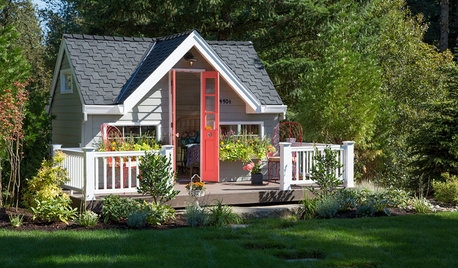when to repot a cutting from perlite to "adult" mix
greentoe357
10 years ago
Related Stories

ROOM OF THE DAYRoom of the Day: A Bright, Colorful Playroom for Kids and Adults
Fun colors mix with sophisticated furnishings and finishes to create an addition suitable for child’s play and adult relaxation
Full Story
OUTBUILDINGSAdults Allowed: A Poolside Playhouse Makes Room for All
Sprightly but not saccharine, this adaptable backyard structure is equally at home with the grandkids and the grown-ups
Full Story
DECORATING GUIDESAn Expat’s Guide to Making a Home Away From Home
How do you stay balanced when each foot is in a different culture? You take a stand where you hang your hat
Full Story
ENTERTAININGHow to Stay Sane When Hosting Christmas
We offer a dozen tips for getting organizing and enjoying the big day
Full Story
HOME OFFICESQuiet, Please! How to Cut Noise Pollution at Home
Leaf blowers, trucks or noisy neighbors driving you berserk? These sound-reduction strategies can help you hush things up
Full Story
KITCHEN DESIGN9 Questions to Ask When Planning a Kitchen Pantry
Avoid blunders and get the storage space and layout you need by asking these questions before you begin
Full Story
HOLIDAYSHow to Care for Your Christmas Tree
Keep your tree looking lush until the last ornament is packed away with these tips for watering, using stands and more
Full Story
LIFEHow to Celebrate National S’mores Day When You Don’t Have a Campfire
Too hot to toast marshmallows? Never got around to building that fire pit? These recipes are for you
Full Story
GARDENING GUIDES7 Ecofriendly Gardening Ideas That Also Cut Chore Time
Spend less time weeding, less money watering and more moments just sitting back and enjoying your healthy garden
Full Story
HEALTHY HOME6 Tips From a Nearly Zero-Waste Home
Lower your trash output and increase your quality of life with these ideas from a mom who did it to the max
Full StorySponsored
More Discussions











greentoe357Original Author
petrushka (7b)
Related Professionals
West Milford Landscape Architects & Landscape Designers · Ferndale Landscape Architects & Landscape Designers · Severn Landscape Architects & Landscape Designers · Clayton Landscape Contractors · Doctor Phillips Landscape Contractors · East Haven Landscape Contractors · Harvey Landscape Contractors · Nanuet Landscape Contractors · North Canton Landscape Contractors · Nutley Landscape Contractors · Plantation Landscape Contractors · Post Falls Landscape Contractors · Washington Landscape Contractors · Westbury Interior Designers & Decorators · Livingston Handymantapla (mid-Michigan, USDA z5b-6a)
greentoe357Original Author
four (9B near 9A)
pirate_girl
tapla (mid-Michigan, USDA z5b-6a)
four (9B near 9A)
tapla (mid-Michigan, USDA z5b-6a)
pirate_girl
tapla (mid-Michigan, USDA z5b-6a)